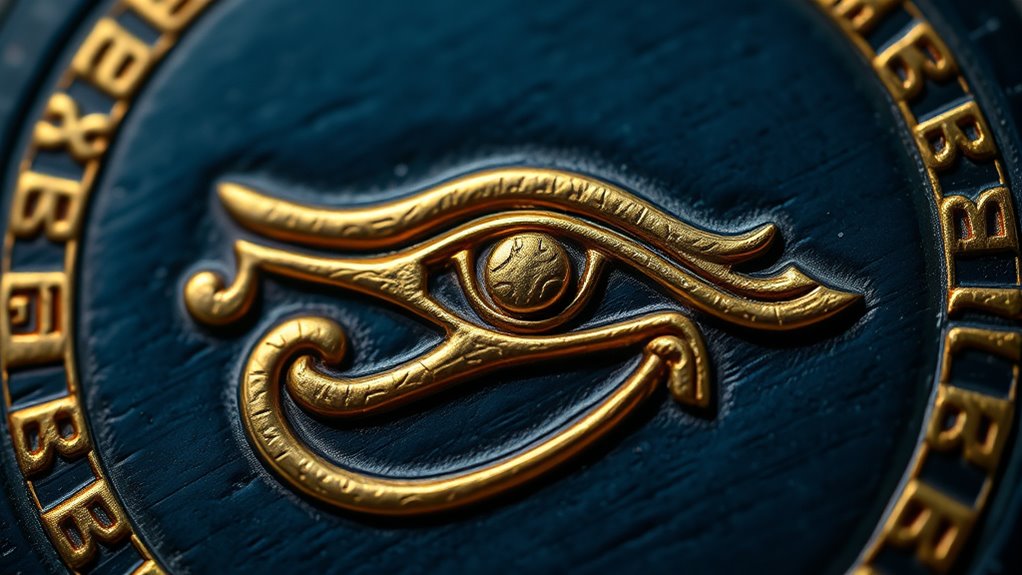The Eye of Horus is an ancient Egyptian symbol known for offering protection, health, and strength. It comes from a myth where Horus lost his eye in battle and Thoth restored it, symbolizing healing and renewal. People used it on amulets and tombs to ward off evil spirits and guarantee safe passage to the afterlife. Today, it appears in jewelry, art, and spiritual practices, symbolizing resilience and safety—discover more about its deep mythological roots and modern significance.
Key Takeaways
- The Eye of Horus symbolizes protection, health, and royal power in ancient Egyptian mythology, originating from the myth of Horus and Seth.
- It was believed to have protective powers, often inscribed on amulets and tombs for safe passage into the afterlife.
- The symbol represents healing and renewal, stemming from the myth where Thoth restores Horus’s lost eye.
- In modern times, it is used in jewelry, tattoos, and spiritual practices as a talisman against negative energies.
- The Eye of Horus remains a powerful cultural symbol of resilience, safety, and divine protection across centuries and contexts.

Have you ever wondered about the meaning behind the Eye of Horus? This powerful symbol has a rich mythological significance rooted in ancient Egyptian culture, representing protection, health, and royal power. According to myth, Horus, the falcon-headed god, lost his eye in a battle with Seth, the god of chaos. The eye was later restored by the god Thoth, symbolizing healing and renewal. This mythological story underscores the Eye of Horus’s role as a symbol of protection and restoration, which has persisted through centuries. Today, you’ll find this ancient emblem used in various modern contexts, from jewelry and tattoos to spiritual practices. Its enduring popularity stems from its deep-rooted symbolism and striking design, making it a universal emblem of protection and good fortune.
In ancient times, Egyptians believed the Eye of Horus possessed protective powers that could ward off evil spirits and safeguard the wearer. It was commonly inscribed on amulets and tombs to secure safe passage into the afterlife. These amulets were thought to harness the mythological significance of the symbol, offering spiritual protection and health. Over the centuries, its influence has transcended Egyptian borders, inspiring symbols in other cultures and modern spiritual practices. Today, many wear the Eye of Horus as a talisman to attract positive energy or to shield themselves from harm. Its image is often incorporated into jewelry designs, tattoos, and even home décor, serving as a reminder of protection and resilience.
You might also notice the Eye of Horus in contemporary art and pop culture, where it’s used to evoke mystery and ancient wisdom. Its striking, stylized appearance lends itself well to graphic design and fashion, making it a popular motif among those interested in ancient symbolism. In spiritual circles, the eye often symbolizes intuition, insight, and protection against negative energies. People use it in meditation or as a visual cue to focus their intentions, connecting the ancient mythological significance to personal growth and mindfulness. Whether as a piece of jewelry, a tattoo, or a decorative object, the Eye of Horus continues to serve as a powerful symbol. It reminds you of the timeless human desire for protection, healing, and connection to the divine, bridging the ancient world with contemporary life.
In essence, the Eye of Horus remains a compelling emblem that combines mythological significance with modern uses. Its story of healing and protection resonates across ages, making it more than just an ancient Egyptian symbol. It’s a universal emblem that embodies resilience and safety, constantly evolving while maintaining its ancient roots. When you see or wear the Eye of Horus, you’re connecting with a symbol that has endured for thousands of years, a testament to its enduring power and relevance.
Frequently Asked Questions
How Was the Eye of Horus Used in Daily Ancient Egyptian Life?
You wore the Eye of Horus as protective jewelry, believing it safeguarded you from harm and evil spirits. During daily rituals, you might have carried or displayed the symbol to guarantee safety and health. Its powerful meaning made it a common accessory, helping you stay protected throughout your day. This ancient amulet served both spiritual and practical purposes, reinforcing your connection to divine protection and well-being.
Are There Modern Symbols Inspired by the Eye of Horus?
Like a beacon guiding ships safely home, modern jewelry and popular culture draw inspiration from the Eye of Horus. You’ll see its symbols in necklaces, tattoos, and fashion, embodying protection and insight. These modern adaptations serve as allegories for wisdom and safety, connecting ancient symbolism to contemporary life. You become part of a timeless story, where the eye’s watchful gaze continues to inspire and protect in today’s world.
What Materials Were Used to Create Eye of Horus Amulets?
You’ll find that eye of Horus amulets were crafted using a variety of materials, including metals like gold, silver, and copper, along with stones such as carnelian, turquoise, and faience. Artisans used techniques like inlay, casting, and engraving to shape and decorate these amulets. These materials and crafting methods helped create powerful symbols believed to offer protection, healing, and good fortune in ancient Egypt.
Did the Eye of Horus Have Any Influence Outside Egypt?
You’ll find that the Eye of Horus influenced cultures beyond Egypt through cultural diffusion. It’s appeared in contemporary jewelry, symbolizing protection and health, showing its lasting impact. As you wear or study these pieces, you see how ancient symbolism continues to resonate, connecting modern designs with historical beliefs. This ongoing influence highlights the Eye of Horus’s enduring power, transcending borders and time periods to inspire people worldwide.
How Has the Symbolism of the Eye of Horus Evolved Over Time?
Like a story passed through generations, the eye’s symbolic evolution reflects changing beliefs and values. You see it now as a symbol of protection, healing, and spiritual insight across cultures. Its cultural significance has expanded beyond Egypt, inspiring art, jewelry, and tattoos worldwide. Over time, it’s become a universal emblem of vigilance and inner strength, reminding you of the enduring power of ancient symbols to resonate deeply in modern lives.
Conclusion
You might be surprised to learn that the Eye of Horus was so powerful it was often used as a symbol on amulets and jewelry, with over 70% of ancient Egyptian artifacts featuring this emblem. Its protective qualities still resonate today, making it a timeless symbol of safety and health. So next time you see it, remember you’re looking at an icon that once guarded an entire civilization—and continues to inspire us now.











